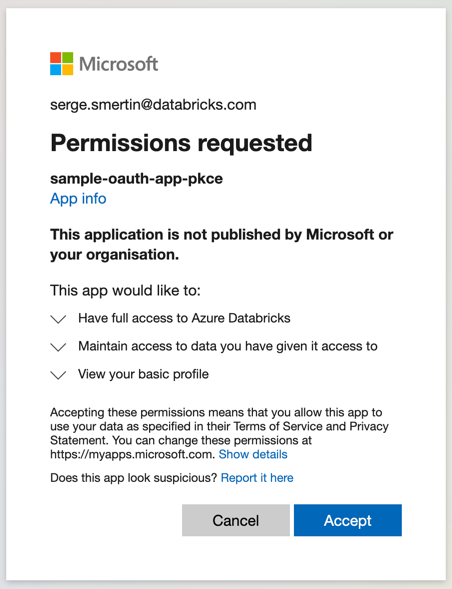Single-Sign-On (SSO) with OAuth¶
Integration with Azure Active Directory¶
Azure CLI Authentication¶
You can natively use credentials provided to az login (Azure CLI). The only argument you’ll have to supply is host.
The SDK code for them should look like the following:
from databricks.sdk import WorkspaceClient
w = WorkspaceClient(host='https://adb-30....azuredatabricks.net')
clusters = w.clusters.list()
for cl in clusters:
print(f' - {cl.cluster_name} is {cl.state}')
This is the recommended way to for local-machine development with Azure Databricks, as you don’t have to store any
credentials in the clear text and Azure CLI handles it all for you. When you have to run application in production,
please supply ARM_CLIENT_ID, ARM_TENTANT_ID, and ARM_CLIENT_SECRET environment variables for
the Service Principal auth to activate.
PKCE 3-legged OAuth flow on local machines¶
You can make your command-line applications running on development machines authenticate with Azure AD Single-Page Application (SPA) flow by using creating the following application with terraform:
data "azuread_client_config" "current" {}
resource "azuread_application" "pkce" {
display_name = "sample-oauth-app-pkce"
owners = [data.azuread_client_config.current.object_id]
sign_in_audience = "AzureADMyOrg"
single_page_application {
redirect_uris = ["http://localhost:8080/"]
}
}
output "pkce_app_client_id" {
value = azuread_application.pkce.application_id
}
The SDK code for them should look like the following:
from databricks.sdk import WorkspaceClient
w = WorkspaceClient(host='https://adb-30....azuredatabricks.net',
client_id='>>>value_from_pkce_app_client_id output<<<<',
auth_type='external-browser')
clusters = w.clusters.list()
for cl in clusters:
print(f' - {cl.cluster_name} is {cl.state}')
It will launch a browser, prompting user to login with Azure credentials and give consent like described on the following screen:

After giving consent, the user can close the browser tab:

Public Client 3-legged OAuth flow on local machines¶
You can make your command-line applications running on development machines authenticate with Public Client AuthCode flow by using creating the following application with terraform:
resource "azuread_application" "public_client" {
display_name = "sample-oauth-app-public-client"
owners = [data.azuread_client_config.current.object_id]
sign_in_audience = "AzureADMyOrg"
public_client {
redirect_uris = ["http://localhost:8080/"]
}
}
output "public_client_id" {
value = azuread_application.public_client.application_id
}
The SDK code for them should look like the following:
from databricks.sdk import WorkspaceClient
w = WorkspaceClient(host='https://adb-30....azuredatabricks.net',
client_id='>>>value from public_client_id output<<<<',
auth_type='external-browser')
clusters = w.clusters.list()
for cl in clusters:
print(f' - {cl.cluster_name} is {cl.state}')
Private OAuth Apps 3-legged OAuth flow on local machines¶
You can make your command-line applications running on development machines authenticate with Private App AuthCode flow by using creating the following application with terraform:
resource "azuread_application" "private_client" {
display_name = "sample-oauth-app-private-client"
owners = [data.azuread_client_config.current.object_id]
sign_in_audience = "AzureADMyOrg"
web {
redirect_uris = ["http://localhost:8080/"]
}
}
resource "time_rotating" "weekly" {
rotation_days = 7
}
resource "azuread_application_password" "private_client" {
application_object_id = azuread_application.private_client.object_id
rotate_when_changed = {
rotation = time_rotating.weekly.id
}
}
output "private_client_id" {
value = azuread_application.private_client.application_id
}
output "private_client_secret" {
value = azuread_application_password.private_client.value
sensitive = true
}
The SDK code for them should look like the following:
from databricks.sdk import WorkspaceClient
w = WorkspaceClient(host='https://adb-30....azuredatabricks.net',
client_id='>>> value from private_client_id <<<',
client_secret='>>> value from private_client_secret <<<',
auth_type='external-browser')
clusters = w.clusters.list()
for cl in clusters:
print(f' - {cl.cluster_name} is {cl.state}')
Azure Active Directory Service Principals 2-legged OAuth flow on CI/CD¶
When running an application in an automated environment without user interaction, you should use AAD SPN flow. You can create AAD Service Principal with secret using the following Terraform code:
variable "name" {
type = string
}
resource "azuread_application" "this" {
display_name = var.name
}
resource "azuread_service_principal" "this" {
application_id = azuread_application.this.application_id
}
resource "time_rotating" "month" {
rotation_days = 30
}
resource "azuread_service_principal_password" "this" {
service_principal_id = azuread_service_principal.this.object_id
rotate_when_changed = {
rotation = time_rotating.month.id
}
}
output "client_id" {
description = "value for ARM_CLIENT_ID environment variable"
value = azuread_application.this.application_id
}
output "client_secret" {
description = "value for ARM_CLIENT_SECRET environment variable"
value = azuread_service_principal_password.this.value
sensitive = true
}
The SDK code to use it would look like the following:
from databricks.sdk import WorkspaceClient
w = WorkspaceClient(host='https://adb-30....azuredatabricks.net',
azure_client_id='>>> value from client_id <<<',
azure_client_secret='>>> value from client_secret <<<',
azure_tenant_id='>>> your Azure Tenant ID <<<')
clusters = w.clusters.list()
for cl in clusters:
print(f' - {cl.cluster_name} is {cl.state}')
On a local machine, you can also store Azure Service Principal credentials in the ~/.databrickscfg file and refer to
them as profile argument in the SDK/CLI/Terraform configuration:
[spn]
host=https://adb-30....azuredatabricks.net
azure_client_id=00000000-0000-0000-0000-000000000001
azure_client_secret=00000000-0000-0000-0000-000000000002
azure_tenant_id=00000000-0000-0000-0000-000000000003
The SDK code to use it would look like the following:
from databricks.sdk import WorkspaceClient
w = WorkspaceClient(profile='spn')
clusters = w.clusters.list()
for cl in clusters:
print(f' - {cl.cluster_name} is {cl.state}')
You can also supply the ARM_CLIENT_ID, ARM_TENTANT_ID, and ARM_CLIENT_SECRET environment variables instead of
hardcoded configuration properties.
SSO for local scripts on development machines¶
For applications, that do run on developer workstations, Databricks SDK for Python provides auth_type='external-browser'
utility, that opens up a browser for a user to go through SSO flow. Azure support is still in the early experimental
stage.
from databricks.sdk import WorkspaceClient
host = input('Enter Databricks host: ')
w = WorkspaceClient(host=host, auth_type='external-browser')
clusters = w.clusters.list()
for cl in clusters:
print(f' - {cl.cluster_name} is {cl.state}')
Creating custom OAuth applications¶
In order to use OAuth with Databricks SDK for Python, you should use account_client.custom_app_integration.create API.
import logging, getpass
from databricks.sdk import AccountClient
account_client = AccountClient(host='https://accounts.cloud.databricks.com',
account_id=input('Databricks Account ID: '),
username=input('Username: '),
password=getpass.getpass('Password: '))
logging.info('Enrolling all published apps...')
account_client.o_auth_enrollment.create(enable_all_published_apps=True)
status = account_client.o_auth_enrollment.get()
logging.info(f'Enrolled all published apps: {status}')
custom_app = account_client.custom_app_integration.create(
name='awesome-app',
redirect_urls=[f'https://host.domain/path/to/callback'],
confidential=True)
logging.info(f'Created new custom app: '
f'--client_id {custom_app.client_id} '
f'--client_secret {custom_app.client_secret}')
